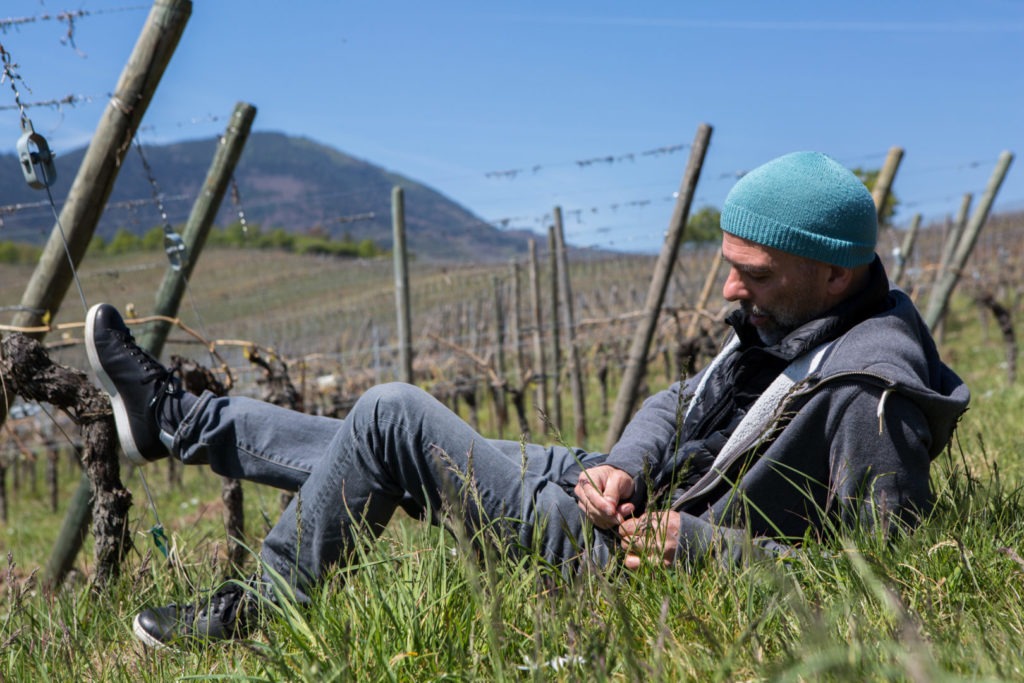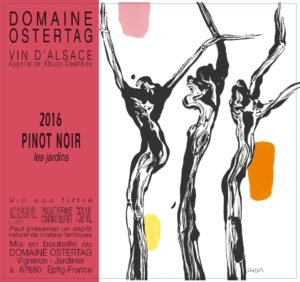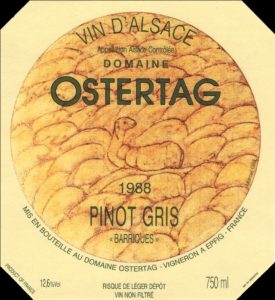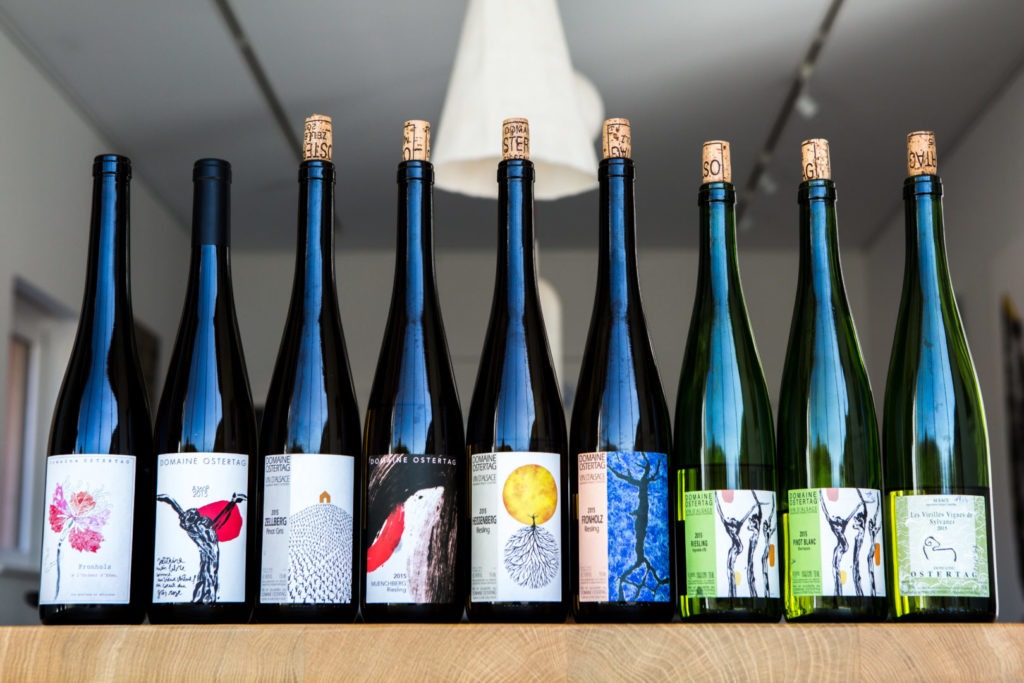André OSTERTAG
DATE OF DOMAIN REVIEW – August 2017
Much has changed during the last five years with André retiring, then returning to the domaine in 2022. So treat this article as a point in time and brief history of the winemaker and the place.
The Location:
André Ostertag’s winery is a complex of buildings on the edge of the town of Epfig, which lies midway between Strasbourg and Colmar, about 35 kilometres from each. Epfig is 5 km east from the long snaking line where the Alsace vineyards hug the lower hills of the Vosges Mountains, and it is one of the few wine towns/villages that doesn’t sit bang on the wine route. See the map for the location. The Romans settled here and named their village Epiacum. We assume they planted a few vines, and fragments of Roman pottery continue to turn up as the vineyards are worked.
The Winemaker:
“When I taste a wine I distinguish very clearly the wines which have life or don’t have life. This is personal, and it’s me that senses this in an intimate way. In the wines with life there is a form of vibration and resonance that touches you more profoundly than other wines.”
- André Ostertag quoted (and translated) in the opening sequence from Sergey Tsoller’s 2017 film, L’Invisible.
The Ostertag domaine was established in 1966 by Andrés father, and that counts as start-up material in Alsace, where domaines often go back ten to fifteen generations. André took over in 1980 following winemaking studies in Burgundy. In Alice Feiring’s recent book The Dirty Guide to Wine, she writes that the Alsace region is filled with philosophers and thinkers, and immediately goes on to quote André Ostertag. Often referred to as a philosopher and poet, we also see André as a director, maître de scene, auteur, and transformer.
He believes in, and frequently mentions, the team that contribute to Domaine Ostertag and produce such a fascinating range of wines:
André Ostertag – the winemaker and maître de scene
Christine Colin – resident artist and André’s partner
Arthur Ostertag – son and recently returned to the domaine after studies in Burgundy and international internships
Annie Schaller – sister and domaine administration
Hubert Schaller – orders, shipments and moving wine out
Hubert Mathis – chef de culture, the vineyard manager
Boris Kachelhoffer – future chef de culture
Doris Ferry – additional vineyard activity
Thomas Larmoyer – commercial and marketing activities
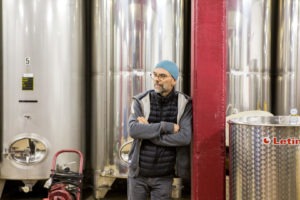
The transformer tag fits in several ways. André has been a constant ambassador for Alsace wines based on the quality and high definition of the wines he makes. He has established himself as an international reference and this has benefitted Alsace wines more widely. He is a key member of ACT (Alsace – Association Crus et Terroir) and was the major contributor to the ACT chart. The Back In Alsace report on ACT is in our Stories section. He made charismatic appearances in Jason Wise’s 2016 film SOMM – Into The Bottle and in the previously quoted Sergey Tsoller’s film, L’Invisible. Andre’s appearances in L’Invisible, brings back memories of the sheer presence of Aimé Guibert in Jonathan Nossiter’s 2004 cult documentary Mondovino. Anyway, you get the idea; André gets the message across through multiple mediums.
The energy that he takes to the international stage, led him to set up a winemaking initiative in Chile’s Casablanca Valley with photographer and resident Julio Donoso. This started back in 2005 when 5 hectares of vineyards were planted on the 21-hectare estate. The Montsecano project is focused on Pinot Noir raised in concrete eggs. Nothing like being “Far From Alsace”: top notch, bio-dynamically farmed Pinot Noir from South America. And as part of that international reach, Montsecano presented and poured their wines at the RAW natural wine salons in New York and Los Angeles in November 2017.
Before that, back home in Alsace in the early 1980’s, André was pioneering. He was the winemaker who introduced barriques for white pinot production, an innovation that was met with various levels of resistance from the Alsace wine authorities. One of the drivers here was to explore a renaissance of Pinot Gris from Burgundy, a wine making tradition that had been swept away by phylloxera and A.O.C. regulations. André’s persistence and ability to produce high quality wines won through and this method is now accepted in Alsace and adopted by many of the winemakers that make a difference.
The labels on the Ostertag range of wines are designed, drawn and painted by Christine Colin. She is one of many artists who work in close collaboration with Alsace winemakers, and Christine’s work brings a sense of beauty and meaning to the labels on these flute bottles. She also created the range of ceiling lamps that hang in the domaine tasting room – a series based on solid objects that go with liquid wine.
The Vineyards and the Wines:
“If you talk about wine you have first to talk about the vines. “
- André Ostertag, L’Invisible:
Annual production is in the region of 85,000 bottles with around 60% going for export. The November 2017 domaine “availability” list has 14 different cuveés from the 2016 vintage and four from the 2015 vintage. This tells you that it’s mostly all gone from the year before and that Hubert Schaller is a busy man.
Having this range of wines in Alsace allows producers to tell a story and explain what’s on offer. This is done really well here with the wines being organised into the domaines own classifications; Les Vins de Fruit, the varietal expression cuveés; Les Vins de Pierre, the terroir driven cuveés; and Les Vins de Temps, late harvest cuveés that depend on the weather (le temps) for ripening and the development of botrytis.
The 15 hectares are split into 88 parcelles/plots and André Ostertag refers to these as 88 gardens (les jardins). The gardens are spread across the Muenchberg grand cru, four lieux-dits (roughly north to south – Fronholz, Zellberg, Heissenberg and Clos Mathis), plus multiple village plots around Epfig, Nothalten, Itterswiller and Albé. Biodynamic farming has been practiced since 1996 and the domaine carries certification from Demeter. Some horse work has recently been introduced for soil management and this will most likely expand in the next couple of years.
Les Vins de Fruit – These wines come from parcelles outside the lieu-dit or the grand cru vineyards. The wines are based on the grape variety, and the blend from the different parcelles provides an approach that defines a high quality “village wine”. These wines are slowly pressed, fermented with natural yeast, and sit on their lees for almost a year before bottling. The Sylvaner, Gewürztraminer, Riesling and Pinot Noir are raised in stainless steel tanks. The Pinot Blanc and Pinot Gris are raised in barriques. The Vins de Fruit range is always in a signature green bottle with dancing vines on the label. The exception is the Vieilles Vignes Sylvaner with its stylised sheep and rolling hilltops on the green tinged label – the original symbol of the domaine. Ostertag, which means Easter Day, is referencing the Easter lamb.
Vieilles Vignes Sylvaner 2015 – this is a perfect example of the quality of these “village” wines. Composition comes from ten parcelles around the villages of Epfig and Nothalten. These ‘gardens/jardins’ cover 5 different soil types ranging from granite to clay and the average age of the vines is 55 years. Our tasting notes: very clear with green reflects, white fruit and a touch of lemon on the nose, rich full agrumes on the palate with a touch of salinity that provides good length. Usually the first wine into the bottle each year – and a wine that has substance and delicate alignment.
Les Vins de Pierre – and the four lieux-dits
So back to these four lieux-dits and the eight distinct wines which are produced. It’s not that difficult to set this up, running from north to south:
The Fronholz at Epfig, which starts a few hundred meters from the domaine buildings. André Ostertag has parcelles that make up four hectares, producing Riesling, Pinot Gris, Gewürztraminer, Muscat and Pinot Noir.
One lieu-dit with five cuvees/varieties, what’s going on? Well, the Fronholz is a mound that sits on the plain, faces south and west and has three distinct soil types. So the location and topology are nicely set up to provide a variety of terroirs. As it’s set back from the Vosges it benefits from cooling winds which helps conserve the acidities and the aromatics in the wines. This is coupled with a pronounced structure and minerality, which allows good longevity in the bottle. The summit runs to almost 300 meters and for Alsace there is a fairly unique west-facing slope. The Fronholz was a candidate for Grand Cru classification in the 1980’s and is now a submitted dossier to the INAO for the new Premier Cru classification. That last sentence deserves a story all on its own.
Up at the summit the soils are light, sandy, sprinkled with quartz and fast draining. This part is really a plateau with a long gentle slope towards the south, a site that develops early and is particularly well suited to Riesling. It has a tendency to suffer from drought, which can impact the younger vines. The Riesling from this site is crystalline and sharp, with great acidity and is well balanced with delicate floral aromatics. As you descend the hill, on the full west facing steeper slope, the soil becomes heavier and clayey. This is a late season site, with long, fresh sunny evenings. There are blocks of Pinot Gris and Gewurztraminer on the clay and marl upper slope, with Pinot Noir and Muscat nearer the bottom on mostly marl soil. Pinot Noir is particularly well suited here, where the all-round freshness helps express the full aromatic range of the variety.
Pinot Noir Fronholz 2015 – the plots make up almost 0.5 hectares from 45-year-old vines and a new parcelle of 10 ares was added in 2014. A lot of attention is paid to fruit quality at picking in the vineyard. Yield was just under 30 hl/ha and maceration was on 15% whole bunches for 12 days. The wine is aged in mostly old oak barriques for 11 months. Non-filtered and a minimal dose of sulphur, 15 mg/l, at bottling. An elegant, delicate Pinot Noir with a definite peppery undertone, slight notes of wood, silky, with a level of salinity on the finish. The pointers that make you think of an autumn day. Good to drink now but will definitely develop during the next five to six years.
The Zellberg at Nothalten – an east-facing vineyard that backs onto the Muenchberg Grand Cru. This is a Pinot Gris site with the various parcelles making up 0.5 hectares. The soil is mostly clay with some limestone and the early morning sun makes this an early developing vineyard. This is often the first site to be harvested and the fruit is brought in before there is any over ripeness. We have tasting notes going back to the 2009 vintage, which was noted as full, unctuous, some peach with a definite citrus edge with a dry finish. Another wine very much linked to its terroir.
The Heissenberg at Nothalten – the ”hot mountain” that sits immediately to the west of Nothalten. This is a south-facing vineyard with a soil of pink Vosges sandstone, gneiss and a granitic underlay, Riesling is produced here from 0.75 hectares of forty year-old vines. One of the most complex sites on the domaine, where the heat builds up and is retained, it gives an impression of temperatures 3-4 degrees higher than they actually are. The area develops early, but is often one of the last lieu-dit to be harvested. With its dry air, the site can suffer from prolonged dry periods and a key focus is to keep the soils fresh to counter the heat. The Riesling here can have the body of a red wine, with an indication of tannins, pronounced spices and an obvious mineral tension. A very particular Riesling that is strongly associated with place.
Heissenberg Riesling 2015 – an initial citrus nose changes to more complex spices with a hint of cardamom. Big and full in the mouth with great acidity, strong agrumes and again a short rush of tart spices, which is closed off as the wine finishes long and dry with a steady salinity. A big, powerful complex Riesling, which will drink well and change through several stages of development.
The Clos Mathis at Ribeauvillé – another Riesling site that sits immediately to the north west of the town down in the Haut Rhin. The lieu-dit of 0.5 hectares consists of a number of small parcelles, many of them running horizontally across the steep slope. Most of the soil work is carried out with a small caterpillar track tractor. The site develops early but benefits from fresh evenings with the winds dropping down from the nearby forests and from the valley that cuts into the Vosges. Its a wetter and cooler site that, on average, needs an additional week for ripening compared to the Epfig sites. The soil type is heavily granitic and this produces in the wines a lovely acidic tension that balances the fruit. Another terroir driven cuveé, this time from most southern reach of the domaine. Clos Mathis is part of the bigger Hagel lieu-dit, which is a currently submitted Premier Cru dossier.
Les Vins de Pierre – and the Muenchberg Grand Cru
Muenchberg, the ‘monk’s hill’, is named after the 12th century Baumgarten Abbey located just north of the Grand Cru. The vineyard is an enclosed amphitheatre, crescent shaped and south facing. It covers 17.8 hectares, with Andre Ostertag farming 2.4. The geology is sandstone, littered with volcanic debris, which allows the soil to be fast draining and fast warming. It’s a suntrap and the 900m Ungersberg, a few km directly west, keeps the clouds and rain away. It’s quite an eerie place where the still, calm silence was punctuated by bird song and screeching hawks when we were last there in April 2017. The atmospherics gave the impression that you could sense the spring growth all along the vineyard, like the full crescent was alive and vibrant.
This is a Riesling site where the domaine has 1.75 hectares split across five parcelles mostly in the eastern portion. There is also a 0.4 hectare parcelle of Pinot Gris at the top of the eastern side, which butts against the forest and the Zellberg lieu-dit. This is where the 2,000 bottles of the domaines cult wine the A360P come from. Named after the cadastral/map reference coordinates, as it was initially refused Grand Cru status for being atypical. Both the Pinot Gris and Riesling cuveés have great keeping potential and are very much place-linked wines. As Andre Ostertag explained “ the complexity in these wines is an accumulation of lots of little things”.
The Riesling is aged on the lees for around 12 months in stainless steel vats and drawn off a month before bottling. The Pinot Gris is raised in barriques and this can often go to 15-18 months before the wine is fully dry, settled and ready. This is THE reference in dry Pinot Gris winemaking, spicy, smoky, balanced and unctuous.
We are going to cover the Vins de Temps, another temps. That’s a good excuse for another trip back to Epfig.
Photos by Benoit Cortet – spring 2017 visit. Thanks to André, Thomas and Boris for their patience and information. Notes gathered from several visits that date back to 2011.
The energy of the Muenchberg.
